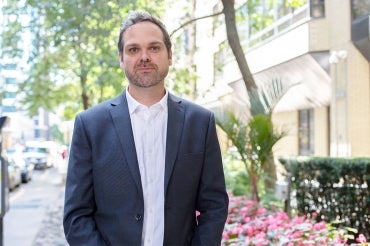U of T researcher calls for end to ‘bedroom jail’ with new pediatric concussion guideline

Published: September 11, 2019
Children and youth who experience concussions shouldn’t be limited to bed rest for weeks after they are injured, says a University of Toronto concussion researcher.
Dr. Nick Reed, who joined the Faculty of Medicine’s department of occupational science and occupational therapy in August as an associate professor, has played a leading role in developing a publicly available guideline on how best to treat and manage pediatric concussions.
The first-of-its kind guideline – known as the Living Guideline for Diagnosing and Managing Pediatric Concussion – was created in Ontario with the input of more than 40 researchers and clinicians from across North America. It contains 60 recommendations that health-care professionals and parents can use to help children and teens navigate their recovery following a concussion, including a call to end what Reed and other researchers refer to as “bedroom jail.”
“In the past, it was recommended that children and adolescents with a concussion should rest completely, with no sports, no school, no friends, no screens, no activity at all – essentially locked in the bedroom, until they no longer had symptoms related to their concussion. Once symptom-free, they could then gradually return to activities,” Reed says.
“We now know, and the guideline recommends, that complete rest for too long after a concussion does more harm than good.”
Reed adds that it’s important to take a balanced approach when it comes to concussion recovery.
“After resting for 24 to 48 hours after a concussion, it is important that children and teens gradually resume activities – even if they are experiencing post-concussion symptoms – like trying to read, going for a walk with friends or even getting back in the classroom with supports in place. These are all activities that can help recovery,” he says.
“That being said, if the activity a child or teen is doing significantly worsens their symptoms, it should be stopped. Injured youths should also stay clear of activities that pose a risk of a repeated concussion, like sports or rough play. And, they should continue to avoid those activities until the symptoms have fully resolved and they have medical clearance to resume.”
Reed and Dr. Roger Zemek, a senior scientist at the CHEO Research Institute, a physician in the division of pediatric emergency medicine at the Children’s Hospital of Eastern Ontario and an associate professor at the University of Ottawa, led development of the guideline.
Reed and Zemek started developing the guideline in 2017, when Reed was a senior clinician scientist at the Holland Bloorview Institute and co-director of the Holland Bloorview Concussion Centre. The Ontario Neurotrauma Foundation initiated and funded the creation of the guideline.
Reed says there has been a dramatic increase in the number of pediatric concussions reported to health-care providers, which could be due to greater awareness about the injuries.
“Now, more than ever, children and adolescents and their families are seeking care for concussion. They need help, they want help, and as the health-care professional community, we need to give them help,” he says.
“In order to provide that, we need to make sure we’re practicing in the most evidence-based way possible, using the great amount of research that’s been produced in the last 10 years to apply to clinical practice. So, to do that, we can use a clinical practice guideline like the guideline we’ve created.”
The creation of the guideline involved researchers from across in North America. They reviewed more than 300 articles, published from 2013 onwards, to distil the top advice.
The researchers met in Toronto for a two-day meeting in October 2018, where they crafted new recommendations that updated prior findings.
The guideline is unique because it will be continually updated to incorporate the latest research, says Reed. He adds that if new research shifts a recommendation or changes clinical practice, the guideline will be updated immediately.
“We want it to be living so that it is never out of date,” he says.
“The goal of this guideline is to make sure that health-care professionals have the best evidence to inform their care when supporting kids with concussion. And, we want to make sure that the newest evidence and research is included in their practices. So, we call this a living guideline because it lives on.”



